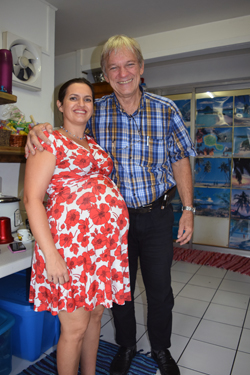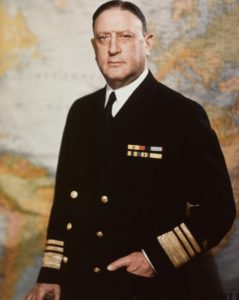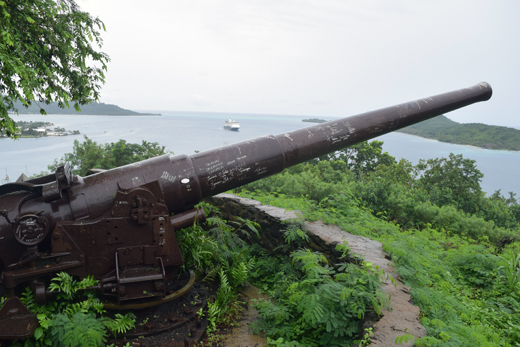Editor’s Note: This is the 27th in a series of stories researched during Don and Nancy Harrison’s 50th Wedding Anniversary cruise from Sydney, Australia, to San Diego. Previous installments of the series, which runs every Thursday, may be found by tapping the number of the installment: 1, 2,3,4, 5, 6, 7, 8, 9, 10, 11, 12,13, 14, 15, 16, 17, 18, 19, 20, 21, 22, 23, 24, 25, 26
By Donald H. Harrison


BORA BORA, French Polynesia – There are many stories that Teva Sylvain, grandson of a rabbi, can tell about his native French Polynesia. The one in particular that captivates him involves the changes that U.S. Admiral Ben Moreell, founder of the Navy Seabees and the grandson of another rabbi, had wrought when the Seabee force he created took over this South Pacific paradise during World War II and built a refueling station for ships and airplanes traveling between the United States and its ANZAC allies of Australia and New Zealand.
Sylvain, a photographer turned entrepreneur who installs solar panels on buildings and sells electric cars from his offices on the neighboring island of Tahiti, has been a longtime proponent of building a museum about the GI experience here on Bora Bora. He had wanted to undertake the project himself, but said that the local French Polynesian government rebuffed him on the grounds that if such a museum were to be built, the government itself should be the one doing it. That was more than a decade ago, and still no action has been taken. Although there have been changes in government since Sylvain first surfaced the proposal, none of French Polynesia’s political leaders has yet taken up the cause.
Still, Sylvain has not given up hope. He had resided for 10 years in Hawaii, where he was impressed with the drawing power of the USS Arizona memorial and its story of the surprise Japanese attack on Pearl Harbor on Dec. 7, 1941. The Seabees ( a transliteration of CBs, for Construction Battalions) landed at Bora Bora slightly more than two months later on February 17, 1942 in what the Navy codenamed “Operation Bobcat.” The U.S. military’s mission was to protect the South Pacific sea route from a Japanese invasion that never came. Although eight heavy artillery guns were erected on four sides of Bora Bora, not one of them ever had to be fired. The Japanese concentrated their efforts elsewhere.
Among the sailors who were sent to Bora Bora was the future novelist James Michener, whose Tales of the South Pacific were in part drawn from his experiences here. His novel was the basis of the beloved Broadway show and movie South Pacific, which helped to popularize the French Polynesian islands as the perfect venue for romantic getaways.
Sylvain has been married four times, and is the father of ten children. At the time of our interview, he and his wife Taina were expecting an eleventh in the very near future. One of his wives was the daughter of a Polynesian woman and an American GI. More than 150 such births had been recorded, in part because of the free and accepting way the Polynesian vahines were ready to share their love with American newcomers. There was little, if any, stigma here to pregnancy without the benefit of marriage, leading to numerous amorous encounters. When American troops were withdrawn from the French-owned island the year following World War II’s conclusion, it was difficult to say who was sadder: the Americans who were leaving their girlfriends, or the young Polynesian women carrying their babies.
Beautiful children were not all that the American GIs left behind. In the four years during which the Seabees and GIs occupied Bora Bora, they had built roads capable of supporting heavy military equipment, an airport, piers, and various other harbor and land improvements. These improvements became the infrastructure upon which much of Bora Bora’s present-day tourist industry is based.

Moreell and Sylvain both trace their lineage to grandfathers who were rabbis. Moreell’s mother, Sophia, was the daughter of Rabbi Joseph L. Sossnitz of Vilna, a 19th century immigrant to the United States whose knowledge of Torah and Hebrew literature was put to use as a cataloguer in New York City’s Astor Library. Sylvain does not know much about his paternal grandfather, except to say that he became estranged from Sylvain’s father after World War II when the latter opted out of Judaism, and married a Gentile. In Tahiti, Sylvain’s father, Adolphe, became a well-known photographer of Tahitian women, and was among those who chronicled Norwegian adventurer Thor Heyerdahl’s successful raft voyage from South America to French Polynesia.
 A proud French Polynesian, Sylvain likes to suggest were it not for the United States’ immediate need during World War II for a South Pacific resupply base, the leader of the Free French and later President of France, Charles DeGaulle, might have been left on the margins of history instead of becoming a central player during World War II and the post-war era. As Sylvain tells the story, relishing Bora Bora’s role, neither Franklin D. Roosevelt nor Winston Churchill could abide DeGaulle, whose arrogance was legendary. However, after Nazi Germany conquered France, the French Polynesians in a local plebiscite voted to ally with the Free French of DeGaulle rather than with the Vichy government of Marshal Henri-Philippe Pétain. Sylvain said that meant that the Allies, in order to establish a base on Bora Bora, needed DeGaulle’s approval. He demanded and received tanks and other military supplies from the Allies.
A proud French Polynesian, Sylvain likes to suggest were it not for the United States’ immediate need during World War II for a South Pacific resupply base, the leader of the Free French and later President of France, Charles DeGaulle, might have been left on the margins of history instead of becoming a central player during World War II and the post-war era. As Sylvain tells the story, relishing Bora Bora’s role, neither Franklin D. Roosevelt nor Winston Churchill could abide DeGaulle, whose arrogance was legendary. However, after Nazi Germany conquered France, the French Polynesians in a local plebiscite voted to ally with the Free French of DeGaulle rather than with the Vichy government of Marshal Henri-Philippe Pétain. Sylvain said that meant that the Allies, in order to establish a base on Bora Bora, needed DeGaulle’s approval. He demanded and received tanks and other military supplies from the Allies.
Whether or not Sylvain has aggrandized Bora Bora’s role in DeGaulle’s career, the fact remains that Operation Bobcat was the initial phase of the Seabees sprint up and down the Pacific, where they built bridges, docks, seaports, airports, housing, supply depots, and transportation hubs. As such, the island has a special—if little known—place in World War II history.

Sylvain says a future Seabee Museum should have a movie theatre in which a documentary film of approximately 45 minutes could highlight the American experience on Bora Bora. In addition to fixed displays at the museum, visitors would be able to take tours of the island in four-wheel drive vehicles capable of climbing a winding dirt road up the mountains to the gun emplacements where American GIs once kept watch over the calm seas lest an enemy vessel appear on the horizon. The guns, initially used in World War I, had been built in 1907 by the Bethlehem Steel company.
Although it had rained extensively in the preceding 24 hours, Nancy and I were able to bump, jolt, and slide over squishy ground in a 4-wheel drive, excellently driven by a guide, to see two large artillery pieces on the western side of the island capable of lobbing ordnance a distance of 10 miles. Had any enemy ship appeared in either Vaitape or Faanui Bay, it would have been exposed to heavy shelling. The view from the gun emplacements was idyllic, well worth the occasionally heart-stopping ride.
*
Harrison is editor of San Diego Jewish World. He may be contacted via donald.harrison@sdjewishworld.com
Pingback: Guide shares the Happe- ness of travel | San Diego Jewish World
Pingback: Tales of two cruise directors | San Diego Jewish World